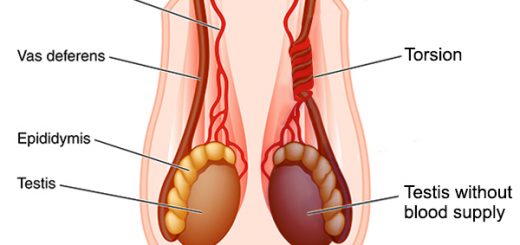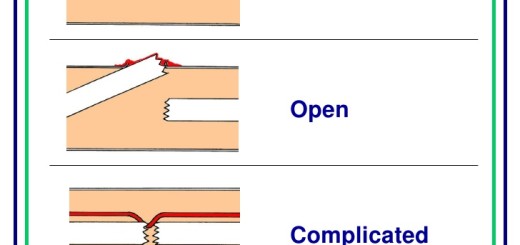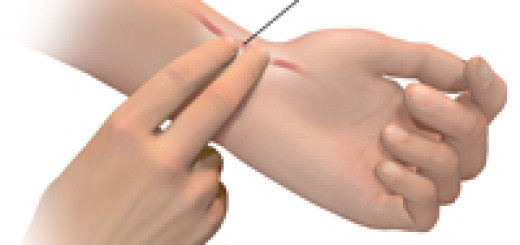How Does CPR Differ in an Unresponsive Adult Choking Victim?
Have you ever encountered a situation in which someone suddenly clutches their throat and finds it difficult to breathe?
According to the American Red Cross, choking is the fourth leading cause of accidental death in adults. But what if that person goes unconscious? Does CPR still work the same way?
The answer is both yes and no, and understanding the crucial differences might be the key to saving a life in that situation.
In this blog post, we’ll explain the steps of CPR for an unresponsive choking adult so you can be prepared to act fast in a moment of crisis.
Standard CPR vs. Choking CPR
Imagine CPR as a two-pronged attack on cardiac arrest. The first prong is chest compressions. By pushing hard and fast on the center of the chest, you’re manually keeping blood pumping throughout the body.
The second prong is rescue breaths. Here, you’re essentially breathing for the person by creating a seal with your mouth over theirs and delivering air into their lungs. This provides much-needed oxygen directly, further supporting vital organs.
Now, choking throws a wrench into this well-oiled machine. When someone’s airway is blocked by a piece of food or another object, oxygen can’t reach the lungs, which is why they struggle to breathe. Standard CPR, with its focus on both chest compressions and rescue breaths, assumes the airway is open.
But for a choking adult who’s become unconscious, the priority shifts. The blockage is an immediate threat to life, so focusing on getting air flowing becomes crucial. That’s where the difference between standard CPR and choking CPR comes in.
So, in standard CPR focus is on getting the person’s breathing back, but in choking CPR priority is to remove the object first that is blocking the airway.
When Does CPR Differ? Recognizing the Unresponsive Choking Adult
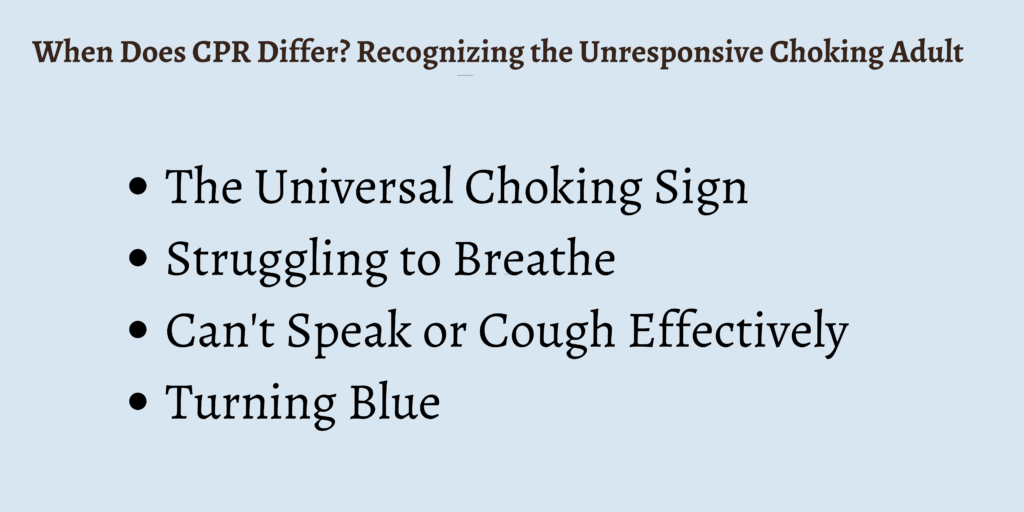
Recognizing an unconscious, choking adult in need of CPR is like piecing together a puzzle. The clues to look for:
- The Universal Choking Sign: This is a big one. If you see someone grabbing their throat with both hands like they’re trying to squeeze something out. It’s a clear signal they’re having trouble breathing.
- Struggling to Breathe: Pay attention to their breathing. Is it shallow, rapid, or wheezing? Can they barely get any air in or out? These are all signs of a blocked airway.
- Can’t Speak or Cough Effectively: If you try to talk to them and they can’t respond or their coughs are weak, it’s a red flag.
- Turning Blue: This might sound scary, but it’s important to be aware. If their lips or fingernails start to turn a bluish color, it’s a sign they’re not getting enough oxygen.
Now, here’s the crucial part: responsiveness. If the person is conscious and coughing or trying to talk, even with difficulty, they might be able to clear the blockage themselves. In that case, hold off on CPR and encourage them to keep coughing. But if they become unconscious and stop showing any of these signs, that’s when CPR with a twist comes into play.
Steps for CPR on an Unresponsive Choking Adult
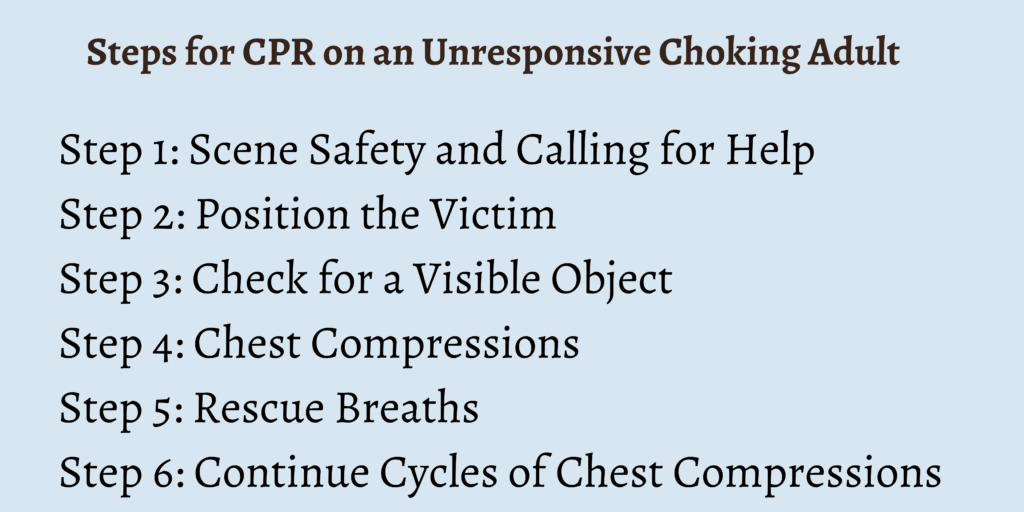
Choking is a terrifying situation, especially when someone loses consciousness. But don’t panic! Here’s a step-by-step guide to performing CPR on an unresponsive choking adult:
Step 1: Scene Safety and Calling for Help
First, make sure it’s safe for you to approach the victim. Look for any dangers in the area and remove them if possible. Then, the most important step, call emergency services immediately! Every second counts in a choking emergency, so don’t hesitate to get professional help on the way.
Step 2: Position the Victim
Gently lay the adult on their back on a flat, hard surface. This allows for better chest compressions and easier airway management.
Step 3: Check for a Visible Object
Open the victim’s mouth with a head tilt/chin lift (tilt the head back slightly and lift the chin with your fingers). Take a quick visual check for a large object lodged in the throat that you can easily remove with one finger sweep.
Important: If you don’t see anything obvious or the object is stuck firmly, don’t waste time with blind finger sweeps! This could push the object further in and make things worse.
Step 4: Chest Compressions
Place the heel of your hand on the center of the victim’s chest, between the nipples. Push down hard and fast. Let the chest rise completely between compressions. This helps keep blood circulating even though the heart isn’t working properly.
Step 5: Rescue Breaths
This is where CPR for choking differs from standard CPR. We’re prioritizing clearing the airway, so for now, we’ll hold off on the rescue breaths. Remember, the blockage is the main issue preventing oxygen from reaching the lungs.
Step 6: Continue Cycles of Chest Compressions
Keep performing cycles of 30 chest compressions until help arrives or the victim shows signs of regaining consciousness. Don’t stop unless you become too exhausted to continue effectively.
This is a simplified version. To learn the technique in detail, it is highly recommended that you take a proper CPR course.
Continuing CPR Until Help Arrives
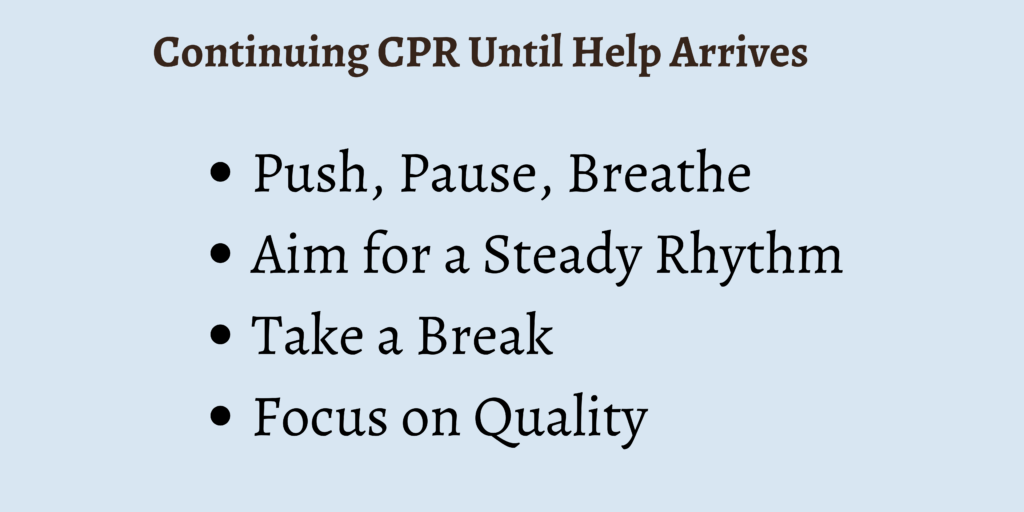
Once you start CPR on an unconscious choking adult, it’s crucial to keep going until help arrives or the person shows signs of waking up. Here’s how to maintain the rhythm:
- Push, Pause, Breathe: Push down hard and fast on the chest for 30 compressions. Then, pause briefly to check for a visible object in the mouth (remember, one quick look only!). Since we’re holding off on rescue breaths, skip that step and go straight back to compressions.
- Aim for a Steady Rhythm: Try to keep your chest compressions at a rate of 100 to 120 per minute.
- Take a Break: If someone else is around, they can take turns doing chest compressions with you. This helps prevent fatigue and ensures you can keep going strong until help arrives.
- Focus on Quality: It’s more important to do good, deep compressions than to get absolutely winded trying to do them too fast.
FAQs
Can I still do CPR on an adult who’s choking, even if they’re unconscious?
Yes. In fact, CPR is crucial for an unconscious, choking adult because they can’t clear the blockage themselves. However, the steps differ slightly from standard CPR. Focus on chest compressions to keep blood flowing, skip the rescue breaths for now, and prioritize techniques to dislodge the object and open the airway.
I saw someone mention the Heimlich Maneuver. Isn’t that what I should do for a choking adult?
The Heimlich Maneuver is a great technique for conscious adults who are choking. However, it’s not recommended for unconscious adults or bystanders who haven’t been trained. In that situation, CPR with a focus on chest compressions is the safest and most effective approach.
This all sounds scary. What’s the most important thing to remember if I see someone choking?
The most important thing is to act fast! Call emergency services immediately, even if the person is still conscious. Then, if they become unconscious, follow the steps for CPR on an unconscious choking adult. Remember, every second counts in a choking emergency.
Conclusion
In conclusion, while the concept of CPR might seem complex, remembering the essential differences for an unconscious choking adult can make a lifesaving difference.
By prioritizing chest compressions and focusing on clearing the airway, you can buy precious time until help arrives.

